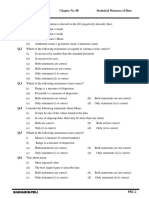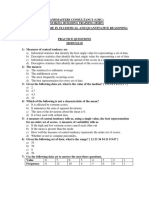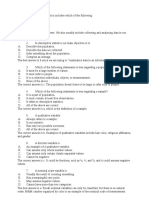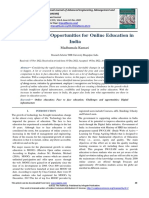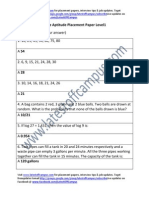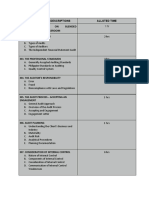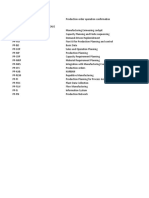Chapter No.
07 Data Collection and Representation
Q.1 Which of the following is correct?
(a) Results of sampling enquiries or a census is called raw data
(b) The data which is collected specifically for the ongoing investigation is called
primary data
(c) The data which is stored after classification and summation is called secondary data
(d) All of the above
Q.2 The human resource director of a large company wants to know what the employees of his
company think about the proposed changes in remuneration package. A questionnaire is
given to 250 employees, 220 employees returned the questionnaire of which 180
employees support the proposed changes in remuneration package. The population is:
(a) 250 employees receiving the questionnaire
(b) All employees of the company
(c) 220 questionnaires which have been returned
(d) 180 employees who support the proposed change in remuneration package.
Q.3 Which of the following statements is/are true about population?
(i) It is desired to consider all the observation.
(ii) In an observation we consider all of the population.
(a) Both statements are correct (b) Both statements are not correct
(c) Only statement (i) is correct (d) Only statement (ii) is correct
Q.4 Which of the following statements is/are true?
(i) There is no gap between discrete data.
(ii) Mid-point is calculated by dividing the sum of upper and lower limit by 2 in each
class
(a) Both statements are correct (b) Both statements are not correct
(c) Only statement (i) is correct (d) Only statement (ii) is correct
Q.5 Which of the following statements is/are correct?
(i) A grouped frequency distribution having class boundaries of discrete data has gaps
between the classes.
(ii) In class boundaries, there is no gap between the classes.
(a) Both statements are correct (b) Both statements are not correct
(c) Only statement (i) is correct (d) Only statement (ii) is correct
Q.6 What is Raw data?
(a) Data often collected in large volume by observation
(b) Originally by investigator/The data collected in surveys
(c) Unprocessed data/Result of sampling enquiries or census
(d) All of these
M. SHOAIB(M.Phil) PRC-2-QM
� Chapter No. 07 Data Collection and Representation
Q.7 Which of the following is correct?
(a) Data which is collected specifically for ongoing investigation is called raw data
(b) Results of sampling enquiries or a census is called primary data
(c) The data which is relevant to the investigation but was collected previously for
some other purpose is called secondary data
(d) All of the above
Q.8 The amount of milk produced by a Cow is
(a) Quantitative variable (b) Discrete variable
(c) Continuous variable (d) Qualitative variable
Q.9 Height of candidates in a school is
(a) Discrete variable (b) Continuous variable
(c) Constant variable (d) All of these
Q.10 The arrangement of data into classes according to the size and magnitude is
(a) Frequency (b) Frequency distribution
(c) Relative frequencies (d) All of these
Q.11 Which of the following statement is not true about continuous variable?
(a) Ages of students (b) Ages of people in Pakistan
(c) Height of all the student in world (d) None of these
Q.12 What is true about HISTOGRAM?
(a) Set of rectangles
(b) Heights are proportionate to frequency
(c) Both A & B
(d) None of these
Q.13 What is true about HISTOGRAM?
(a) A vertical rectangle is drawn to represent each class of the frequency distribution
(b) The frequency of the class is represented by the height of rectangles
(c) Histogram cannot represent continuous data
(d) Both (a) and (b)
Q.14 Which of the following statement regarding histogram is correct?
(a) Set of rectangles
(b) Areas are proportionate to frequency
(c) Both A & B
(d) None of these
M. SHOAIB(M.Phil) PRC-2-QM
� Chapter No. 07 Data Collection and Representation
Q.15 Which of the following graph represent continuous data?
(a) Pie chart (b) Histogram
(c) Polygon (d) All of these
Q.16 The scale of y-axis of Ogive is
(a) Frequency (b) Midpoint
(c) Cumulative frequency (d) None of these
Q.17 Ogive diagram is used for what?
(a) Cumulative frequency distribution (b) Mid-point
(c) Class limits (d) All of these
Q.18 ____ is an example of categorical data
(a) Age (b) Salary
(c) Gender (d) None of the above
Q.19 What are the specifications/characteristics of Ogive?
(a) Cumulative frequency and C.B are used
(b) Median, quartiles deciles & percentiles can be determined from Ogive
(c) Both a & b
(d) None of these
Q.20 The median of a given frequency distribution is found graphically with the help of:
(a) Histogram (b) Pie chart
(c) Frequency curve (d) Ogive
Q.21 Which of the following statement is correct?
(a) Bar charts are usually used for plotting continuous data
(b) Bar charts are usually for plotting discrete data
(c) Bar charts can be plotted horizontally or vertically
(d) Both (b) and (c)
Q.22 The graph obtained by joining the mid points of the tops of adjacent rectangles in histogram
is called ________________?
(a) Histogram (b) Pie chart
(c) Frequency polygon (d) Ogive
Q.23 If peak of a histogram is at center and frequency is distributed evenly throughout data then
data is
(a) Positively skewed (b) Negatively skewed
(c) Normally skewed / Equally distributed (d) None of these
M. SHOAIB(M.Phil) PRC-2-QM
� Chapter No. 07 Data Collection and Representation
Q.24 Construction of a frequency distribution:
(a) Is one of the most common means of summarizing data
(b) Begins by recording the number of times a particular value occurs
(c) Is the basis of construction of a percentage distribution
(d) All of the above
Q.25 Bar graph
(a) Can be used for the continuous distribution
(b) Can be vertical
(c) Can be horizontal
(d) Both (b) and (c)
Q.26 Which of the following is not correct?
(a) Multiple bar charts show the components of totals as separate bars adjoining each
other.
(b) Component bar chart is similar to a simple bar chart but the bars are subdivided
into component parts.
(c) Percentage component bar chart shows each class as a bar of the same height.
However, each bar is subdivided into separate lengths representing the percentage
of each component in a class.
(d) Histogram is a circular chart that displays variables in proportion of the quantity
within a circle
Q.27 Which of the following statements is/are correct?
(i) A grouped frequency distribution of discrete data has gaps between the classes.
(ii) Discrete data can be converted into continuous data.
(a) Both statements are correct
(b) Both statements are not correct
(c) Only statement (i) is correct
(d) Only statement (ii) is correct
Q.28 Which of the following is/are correct regarding primary data?
(i) Data collected by interviewing the parents of the students by school management
(ii) Data collected by interviewing the students by school management
(a) Both statements are correct (b) Both statements are not correct
(c) Only statement (i) is correct (d) Only statement (ii) is correct
M. SHOAIB(M.Phil) PRC-2-QM
� Chapter No. 07 Data Collection and Representation
Q.29 The following data relates to the marks of 50 students
Marks 0--20 20--40 40--60 60--80 80--100
No. of Students 2 12 17 11 8
What is the percentage of the students getting less than 40 marks?
(a) 72% (b) 14%
(c) 28% (d) 17%
Q.30 The number of accidents for seven days in a city is given below
No. of accidents 0 1 2 3 4 5 6
Frequency 15 19 22 31 98 3 2
What is the number of cases when 2 or fewer accidents occurred?
(a) 26 (b) 87
(c) 56 (d) 21
Q.31 A ____ chart is a chart with rectangular bars with lengths proportional to the values that
they represent.
(a) Pie (b) Bar
(c) Histogram (d) Ogives
Q.32 A ____ is a graph that shows the frequency of numerical data using rectangles.
(a) Pie (b) Bar
(c) Histogram (d) Ogive
Q.33 ____ is an example of categorical data
(a) Height (b) Salary
(c) Habit (d) Population of a city
Q.34 Properties of ordinal data are:
1. Shows relative ranking of the variables
2. Numbers have meaningful order
3. Magnitude of the values is not important, but the order is
(a) 1 only (b) 1 and 2 only
(c) All of the above (d) None of the above
Q.35 Numbers on the uniform of cricket team members represent:
(a) Cross sectional (b) Structured
(c) Nominal (d) Ordinal
M. SHOAIB(M.Phil) PRC-2-QM
� Chapter No. 07 Data Collection and Representation
Q.36 Types of data includes:
(a) Numerical and Categorical (b) Discrete and continuous
(c) Ordinal and Nominal (d) All of the above
Q.37 Example of time series data is:
(a) Year-wise sales revenue over a period of time
(b) Quarterly production of units over a period of time
(c) None of the above
(d) Both A and B
Q.38 A ____ graph is one that has time on the horizontal axis and a variable on the vertical axis
(a) Histogram (b) Pie
(c) Box and whisker (d) Time series
Q.39 An ____ is a graph of a cumulative frequency distribution. Frequencies are accumulated
at each level and are plotted against upper class limits of each class, and the points
are joined with a smooth curve.
(a) Pie (b) Bar
(c) Histogram (d) Ogive
Q.40 Example of continuous data is:
(a) Number of seats in a room
(b) Number of students in a class
(c) Height of a building
(d) Collar size
**************************************************
M. SHOAIB(M.Phil) PRC-2-QM










